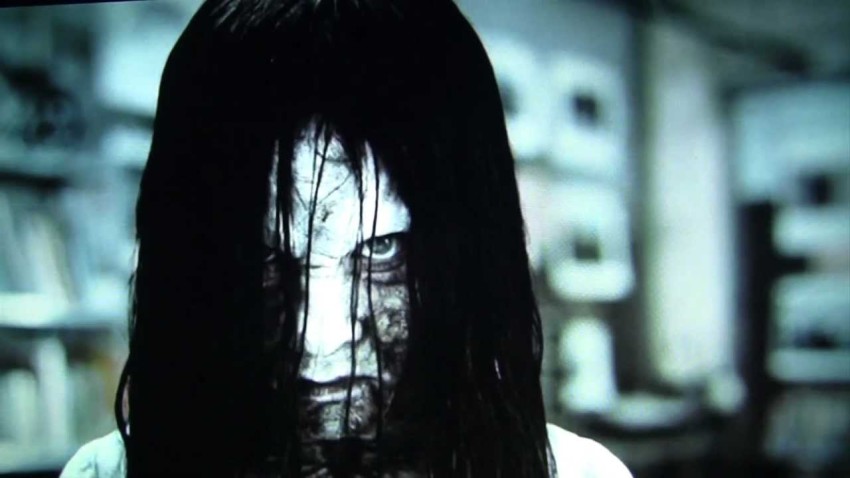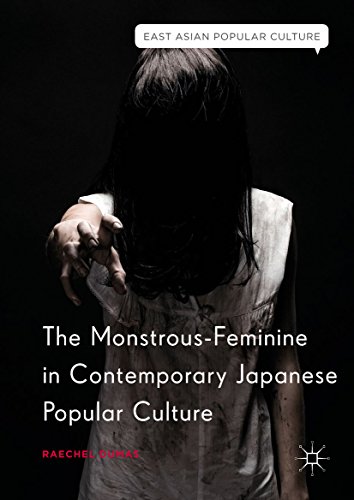Books: The Monstrous Feminine
February 28, 2019 · 0 comments
By Shelley Pallis.
 In the midst of a British media panic about “Momo”, a slit-mouthed Japanese woman who supposedly exhorts children to commit crimes, there’s never been a better time to investigate the world of dangerous Japanese ghost-girls. Barbara Creed’s landmark book The Monstrous-Feminine (1993) kicked off an entire subgenre of writing about Monstrous Wombs, Archaic Mothers, Castatrices and Vampires. San Diego academic Raechel Dumas has probably had a lot more fun than she is admitting to, mapping Creed’s ideas onto the femmes fatales of another country’s media, with her new book The Monstrous-Feminine in Contemporary Japanese Popular Culture.
In the midst of a British media panic about “Momo”, a slit-mouthed Japanese woman who supposedly exhorts children to commit crimes, there’s never been a better time to investigate the world of dangerous Japanese ghost-girls. Barbara Creed’s landmark book The Monstrous-Feminine (1993) kicked off an entire subgenre of writing about Monstrous Wombs, Archaic Mothers, Castatrices and Vampires. San Diego academic Raechel Dumas has probably had a lot more fun than she is admitting to, mapping Creed’s ideas onto the femmes fatales of another country’s media, with her new book The Monstrous-Feminine in Contemporary Japanese Popular Culture.
The emphasis here is on “contemporary.” Although Dumas is plainly aware of precedents throughout Japanese literary history, she only really tips her hand in the final chapter, which deals with Natsuo Kirino’s Goddess Chronicle. Here, we get a flood of traditional resonances – the crazy ex-girlfriends that litter the Tale of Genji, for example, and Raicho Hiratsuka’s 1911 feminist polemic, “In the beginning, woman was the Sun,” which alludes to Japan’s oldest myths. A more historically minded writer might have detailed these in chronological order, but such a narrative would betray the very essence of Dumas’ stated focus. Classical touchstones don’t trouble a teenage boy shooting his way through Silent Hill, although if he really wanted to scare the willies out of himself, he should stop clubbing mutants and try reading a dreary chapter of cultural theorists Deleuze and Guattari pontificating about it.
What interests Dumas is how such resonances in Silent Hill might have developed out of a culture’s “pragmatic hostility towards women,” and how echoes of WW2, post-war reconstruction and late 20th century stagnation might be discerned in Japanese media. In the case of Silent Hill, she is quick to point out that “not all of Silent Hill’s monsters are female or feminized,” although her descriptions of the ghastly Pyramid Head and the truly horrific Abstract Daddy make it clear that even the male characters owe an incredible deal to misogyny and fear of women. Even monstrous females, she notes, are not necessarily female – she points to Sadako, celebrated antagonist of the Ring series, who in the books but not in the films, turns out to be biologically male.
 A section on the inspirations for Ju-on: The Grudge quotes from a NEO interview by Calum Waddell with its creator, although, Dumas usually avoids engaging with the actual makers of any given work. It would have been interesting, to me, to hear more along the same lines from the authors of Ring and Parasite Eve, or what the designers of Silent Hill might have to say about their inspirations and intentions, but as befits someone in her field, Dumas usually keeps to culture as revealed by its works, not the workers who made them.
A section on the inspirations for Ju-on: The Grudge quotes from a NEO interview by Calum Waddell with its creator, although, Dumas usually avoids engaging with the actual makers of any given work. It would have been interesting, to me, to hear more along the same lines from the authors of Ring and Parasite Eve, or what the designers of Silent Hill might have to say about their inspirations and intentions, but as befits someone in her field, Dumas usually keeps to culture as revealed by its works, not the workers who made them.
Dumas’ real-world references are torn from Japanese headlines of the last thirty years, presenting the reader with a run-down of all the most spectacular disasters and scandals liable to have inspired modern horror creators – the Aum Shinrikyo terror attack, for example, or a gruesome 1997 child-murder case in Kobe. For anyone blundering into a discussion of Japanese horror without a grounding in Japanese society and history, this will be immensely valuable, pointing to allusions and echoes of late 20th century culture in many iconic horror movies, as well as a smattering of books that happen to be available in English. I was left wondering to what extent the books under study mirror a genuine popular appeal, and to what extent they simply reflect the interests and acquisitions of English-language publishers. Was Ken Asamatsu’s intriguing Queen of K’n-Yan, for example, translated into English because it was a representative work of modern Japanese horror, or because it leaned on H.P. Lovecraft’s Cthulhu mythos for its inspiration? It’s entirely feasible, of course, that both answers are true, but I’m none the wiser.
In other words, how popular is popular, here, and popular with whom? In the 1990s, a vagina dentata in Yoshiaki Kawajiri’s Wicked City became a notorious bugbear of the scare-mongering British media, but there is not a word said about that. Nor does Dumas mention the literal monstrous females of Okayado’s manga series Monster Musume (according to Jonathan Clements in NEO, “a harem story presented as a blind terror of women”), but is that because it is also popular abroad, topping the manga sales charts in America and hence possibly less relevant to a Japan-specific enquiry? Similarly, one could hope, in a discussion of the perversion of Buddhist ethics, that there might have been some treatment of the controversial Urotsukidoji, which comes attached to multiple layers of Buddhist-inspired horror, and ends with a sorcerous apocalypse brought about by a girl-goddess’s first menstruation.
 It may seem ill-mannered to bring up things that are not in Dumas’ book, rather than all the wonderful things that are. I note these three examples both to extend the conversation, but also to point to a common feature of cultural studies, as a wordy veil drawn over what might otherwise be a simple expression of fannish enthusiasm. Dumas has commented in the past about her annoyance with the term “guilty pleasure,” but one does sometimes get the impression that she is finding a day-job excuse to share her passion for some things she really likes, rather than attempting an exhaustive synoptic overview. This is a victimless crime – why the hell shouldn’t we talk about things we like? – but it is important not to conflate personal enjoyment with cultural significance.
It may seem ill-mannered to bring up things that are not in Dumas’ book, rather than all the wonderful things that are. I note these three examples both to extend the conversation, but also to point to a common feature of cultural studies, as a wordy veil drawn over what might otherwise be a simple expression of fannish enthusiasm. Dumas has commented in the past about her annoyance with the term “guilty pleasure,” but one does sometimes get the impression that she is finding a day-job excuse to share her passion for some things she really likes, rather than attempting an exhaustive synoptic overview. This is a victimless crime – why the hell shouldn’t we talk about things we like? – but it is important not to conflate personal enjoyment with cultural significance.
All too often, writers on cultural studies use academic cant to conceal their own lack of knowledge on an actual topic, but as a Japanese Studies graduate embedded in a Humanities faculty, Dumas is refreshingly able to walk the walk and talk the talk. Palgrave Macmillan’s American website is actually selling individual chapters for $30 a pop, suggesting that even her publisher suspects that Dumas’ book is more likely to be accessed and appreciated in a fragmented and piecemeal way, rather than approached as a whole that is more than the sum of its parts. But this may well be part of the plan – excerpts from this book are sure to be an irresistible temptation to tutors who face complaints from students that the canon they study is too white, too male, and too highbrow. Also, zombies.
The Monstrous-Feminine in Contemporary Japanese Pop Culture is published by Palgrave Macmillan.
Leave a Reply